Inclusive Playgrounds: How To Create Play Spaces for Children of All Abilities

- Building an inclusive playground requires more creativity and planning than building a standard playground.
- Involving the community in the planning process can help designers understand the needs of local children with different abilities.
- An inclusive playspace should offer something for all senses including hearing, sound, and touch.
- Safety should always be a priority when designing any kind of play environment or outdoor fitness equipment.
Outdoor play is one of the best ways a child can spend their time. The fresh air, sunshine, and time spent with other children are important for the health and well-being of all kids. For parents of children with special needs, an inclusive play space not only enables children to develop physically but also helps them actively engage in meaningful play and develop social skills with other children.
Inclusive playgrounds should consider the needs of the entire community, include sensory play, encourage children to develop physically, and be safe for children of all ages and abilities.
Tip 1: Involve the Community in the Planning Process

The best way to get ideas for an inclusive playground design is to ask the community for their input. Allow the parents and children in need of adaptive equipment to voice their ideas and make requests.
To involve the community in the planning process, designers should:
- Engage with children, parents, and educators of all abilities to gather input.
- Use surveys and community meetings to understand diverse needs.
- Collaborate with local disability advocacy groups for expert advice.
Tip 2: Ensure Physical Accessibility
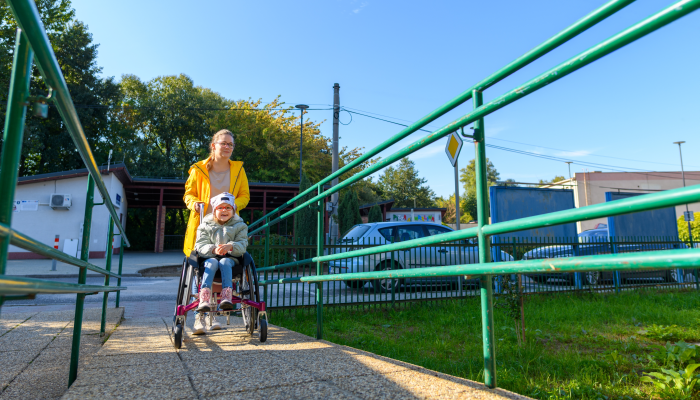
Children of all ages and abilities need physical activity. An inclusive playground can help children with special needs reach the recommended goal of 60 minutes of physical activity each day.
Physical accessibility features include:
- Wheelchair-accessible pathways and ramps.
- Equipment that is accessible from ground level.
- Handrails.
- Supportive seating.
- Large swings with safety buckles.
- Safety railings on all high surfaces.
- Slides wide enough for parents to accompany children.
Tip 3: Incorporate Sensory-Friendly Elements
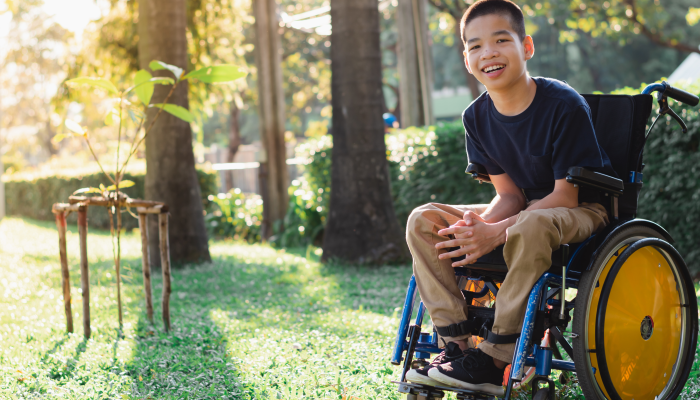
When most people imagine a playground, they picture children participating in physical activities such as running, jumping, and swinging. While these are important parts of play, designers shouldn’t neglect other types of sensory play.
Here are some examples of outdoor sensory play elements for inclusive play:
- Water
- Sand
- Mud
- Grass
- Textured equipment
- Musical instruments
- Color wheels
- Lights
An inclusive playground should have areas with varying sensory experiences, catering to both sensory-seeking and sensory-avoidant children. While playgrounds are typically known for being loud and busy, designers can include a play space that is quiet and shaded for children who are easily overstimulated.
Tip 4: Choose Varied and Adaptive Play Equipment
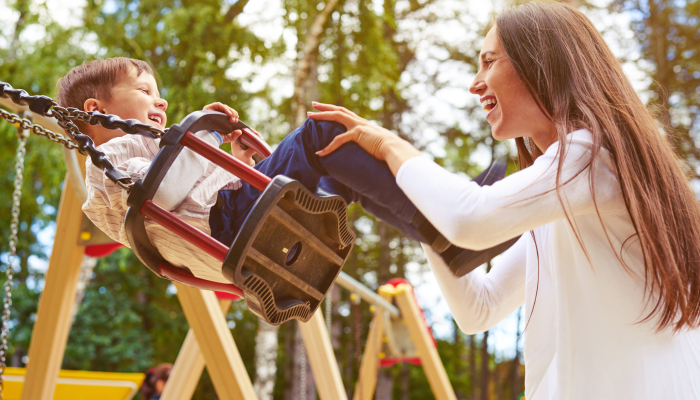
Having an inclusive design does not mean that all equipment has to be used by all children. Some equipment may be better for children in wheelchairs, while other equipment may be better for children with sensory processing disorders.
An inclusive playground should have all kinds of equipment to be used for many different preferences and abilities. For example:
- Physical play. Designers should select equipment that supports different types of movement, such as swinging, spinning, and climbing, with adaptations for various abilities. Inclusive playground equipment may include moving platforms with wheelchair locks and seatbelts to allow children with mobility issues to swing, slide, or spin.
- Imagination. Imaginative fun is just as important as physical activity. In addition to physical movement and sensory play, playground design can incorporate creativity and encourage children to use their imagination, get creative, and work together.
- Sensory experiences. Play experiences can look different for children with disabilities. Offering play options for children with visual impairments, hearing impairments, and sensory processing disorders is just as important as offering options for children with mobility issues.
Tip 5: Promote Social Interaction
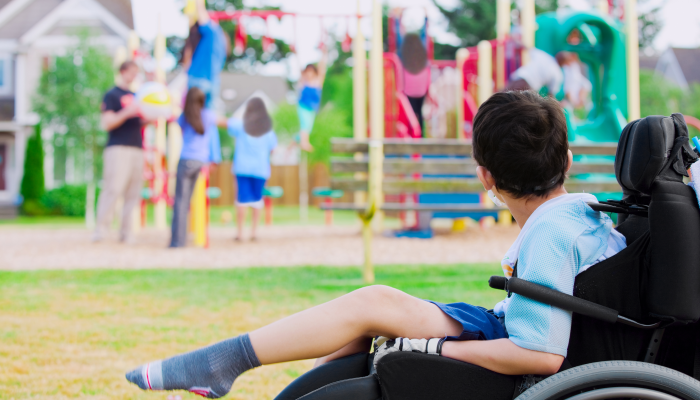
When planning an inclusive play environment, design the playground layout to encourage children of all abilities to play together. This means including equipment that requires cooperative play, like seesaws or tandem swings, and creating inclusive play scenarios that foster friendships and understanding among diverse users.
Inclusive playground designs should bring all children together. Not all children will want to play together all of the time, but designers can offer different ways for children to interact.
Play equipment should allow children to participate in all different types of play including:
- Solitary play: when a child plays alone without any social interaction
- Onlooker play: when a child can watch others play without participating
- Parallel play: when children can play near or next to each other without interacting or cooperating
- Associative play: when children participate in the same activity but do not have to cooperate
- Cooperative play: when children work together to play and engage in activities together
Tip 6: Focus on Safety and Comfort
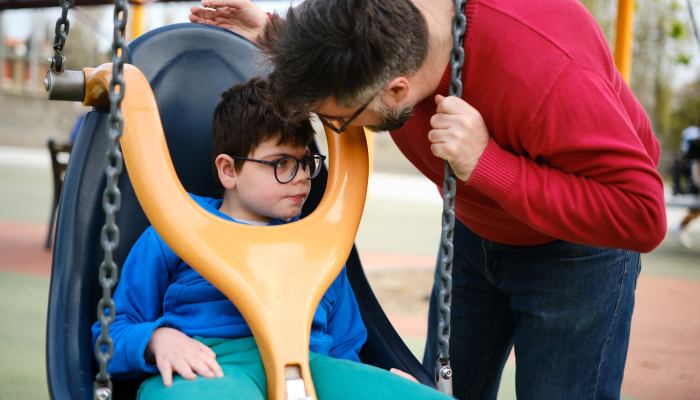
Some essential safety elements to consider when designing an inclusive playground include:
- Fall prevention. Studies from the Iran University of Science and Technology11. Dalal, K., Sadeghi Naeini, H., Lindqvist, K., & Jafrai, H. R.. Playground injuries in children. Open Access Journal of Sports Medicine. 2022;61–68. https://doi.org/10.2147/oajsm.s14487 show that falls are the number one cause of playground injuries, and swings are the equipment most often involved in falls. Offering swings that allow parents to buckle in their children, and enclosing all high platforms can help keep children safe.
- Materials. The commercial playground equipment you choose for your park should be safe, durable, and non-toxic. In addition, ensure that surfaces are made from material that will not get too hot in the sun. According to the Burn and Reconstructive Centers of America22. Playground safety tips from BRCA. Burn and Reconstructive Centers of America. 2022. https://burncenters.com/community/playground-safety-tips-from-brca/#:~:text=According%20to%20the%20American%20Burn%20Association%2C%20if%20the,is%20a%20risk%20of%20sustaining%20a%20thermal%20burn. , a plastic slide can reach 150 degrees when out in the sun on an 80-degree day. Covering these surfaces in shade or choosing material that doesn’t heat up can help.
- Protection from the elements. In addition to using safe materials, playground designers should provide shade, seating, and water fountains for families to use while enjoying the playground.
- Regular inspections. It’s no secret that kids can be hard on equipment and toys. It’s important to regularly inspect and maintain equipment to adhere to safety standards. Make sure to double-check safety latches, seatbelts, gates, and connections to help children avoid accidental injuries.
FAQs
How can community members advocate for the creation of inclusive playgrounds in their area?
Attending community planning functions, creating a committee, and speaking to your government representatives are the best ways to get started on an inclusive playground project. The more community members you can get involved, the stronger your voices will be when asking your community for buy-in.
What are some ways to fundraise for the development of an inclusive playground?
Any parent or community designer can tell you that standard commercial playground equipment is expensive. Unfortunately, inclusive playground equipment can be even more expensive. Local governments are often willing to contribute to inclusive playgrounds, but may not cover the entire cost.
Communities can apply for grants33. Playground Grants. Landscape Structures Inc.. https://www.playlsi.com/en/playgrounds/playground-grant-planning/?msclkid=6a43ae4d8eac1b6dc3a5cbac6d18118d&utm_source=bing&utm_medium=cpc&utm_campaign=CM1_Bing_Planning_General_NB_DMT_US_Prospecting_StandardSearch_D_D_LeadGen&utm_term=playground+fundraiser&utm_content=Playground+Funding&utm_id=bi_cmp-43818480_adg-3793916817_ad-76622373794201_kwd-19761339680%3Aloc-190_dev-c_ext-_prd- , ask large companies for donations in exchange for advertising at the playground, or host community events to raise enough money for the playground.
How do inclusive playgrounds benefit the overall development of children?
Not only do inclusive playgrounds offer an opportunity for children with special needs to exercise and interact with other kids, but inclusive play helps all children learn to work together and accept differences in others.
References
- Dalal, K., Sadeghi Naeini, H., Lindqvist, K., & Jafrai, H. R. (2022). Playground injuries in children. Open Access Journal of Sports Medicine, 61–68. https://doi.org/10.2147/oajsm.s14487
- Playground safety tips from BRCA. Burn and Reconstructive Centers of America. (2022, September 7). https://burncenters.com/community/playground-safety-tips-from-brca/#:~:text=According%20to%20the%20American%20Burn%20Association%2C%20if%20the,is%20a%20risk%20of%20sustaining%20a%20thermal%20burn.
- Playground Grants. Landscape Structures Inc. (n.d.). https://www.playlsi.com/en/playgrounds/playground-grant-planning/?msclkid=6a43ae4d8eac1b6dc3a5cbac6d18118d&utm_source=bing&utm_medium=cpc&utm_campaign=CM1_Bing_Planning_General_NB_DMT_US_Prospecting_StandardSearch_D_D_LeadGen&utm_term=playground+fundraiser&utm_content=Playground+Funding&utm_id=bi_cmp-43818480_adg-3793916817_ad-76622373794201_kwd-19761339680%3Aloc-190_dev-c_ext-_prd-

The information WonderBaby provides is not intended to be, and does not constitute, medical or other health advice or diagnosis and should not be used as such. Always consult with a qualified medical professional about your specific circumstances.
Related Posts

Eye Conditions and Syndromes, Visual Impairment
Neuralink Announces Plans to Restore Sight to the Blind with Brain Chip
Elon Musk’s company Neuralink has announced plans to begin human trials of its new “Blindsight” brain chip by the end of 2025.

Special Needs
5 Spring Cleaning Tips for Families of Children with Disabilities
Spring cleaning is an opportunity to create a more accessible, organized, and supportive space for your child with disabilities. Declutter, deep clean, and refresh!

Visual Impairment
The Gift of Understanding: How a Young Child Helps His Blind Father Navigate Life
When a parent is blind, it’s natural for people to wonder how their sighted child will adapt. Will they struggle to understand their parent’s needs? Will they feel burdened by...